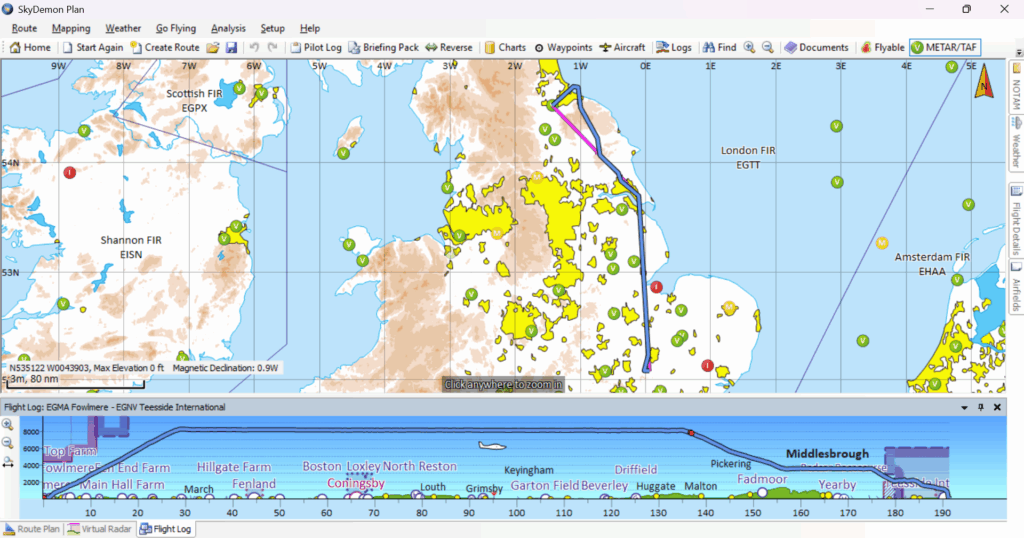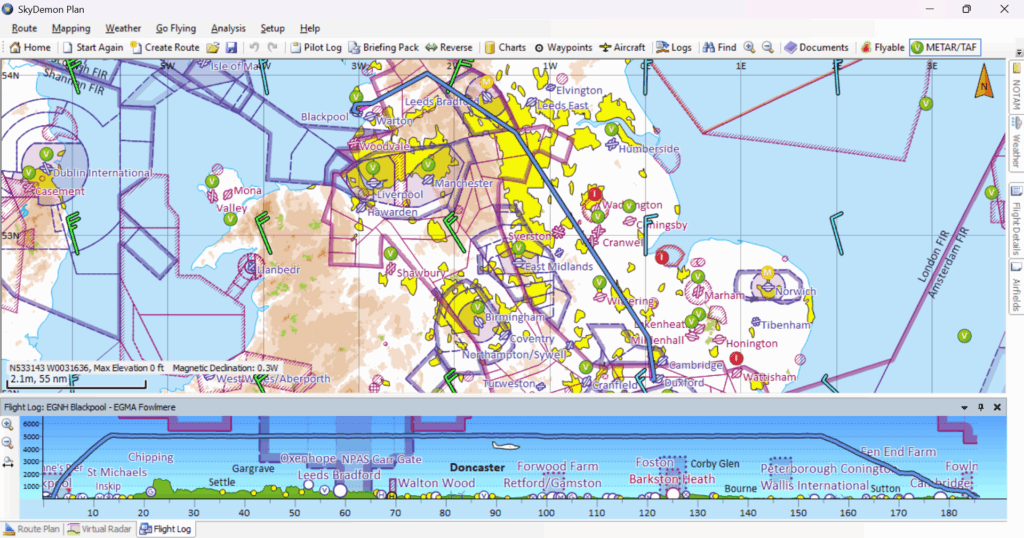Introduction
The UK airspace structure is complex at places but generally covered by large swaths of class G uncontrolled airspace. Most GA flying in the UK happens outside controlled airspace. While this is almost certainly preferable for VFR flying where the freedom of level and routing is convenient and the radiotelephony workload is reduced or eliminated, for IFR flying the same can be debatable. IFR traffic prefers a higher level of ATC service, preferably with separation provided, but reliable traffic information can be a confortable minimum for many. Surprises from gliders and random GA traffic alike are not welcome, and it is the preference of many IFR pilots to stay within controlled airspace as much as possible.
However, in the UK, a GA IFR flight is frequently required to fly in uncontrolled airspace, for the following reasons:
- The airfields to be used can be situated outside controlled airspace, with nothing more than an ATZ, e.g. EGSC, EGHQ.
- There are no airways to some regions in the UK at all, e.g. Cornwall.
- There are probably more IFR GA pilots in the UK that have IMC ratings or IR(R) than those who have full IR. The IMC or IR(R) rating does not allow the use of Class A airspace.
- There is continuous Class C airspace coverage above FL195, however, most GA piston aircraft do not fly at such altitudes. Even if the aircraft is capable, the trip may be too short to warrant climbing to such altitudes.
- The UK has a system, which foreign pilots may find horrifying at first encounter, where once an aircraft exits controlled airspace into Class G, ATC service will reduce to a basic level and subsequent clearance into further controlled airspace is not guaranteed. Any further entry into controlled airspace has to be negotiated with the relevant ATC unit and can be refused, at which point the aircraft has to find alternative routing in uncontrolled airspace. This applies to both VFR and IFR traffic, although the workload increase under IFR will be much higher if caught out off guard.
I’ll use two of my recent flights to illustrate some aspects of planning and conducting an IFR GA flight outside controlled airspace in the UK.
Flight 1: EGMA (Fowlmere) to EGNV (Teesside International)
Fowlmere airfield (EGMA) is an unlicenced airfield situated in Class G airspace and Teesside International (EGNV) is a regional airport with its own CTA and CTR. In between these two locations there is nothing other than open Class G airspace. A direct route is possible but Waddington danger areas were active on the day, hence, I routed via OTR (Ottringham VOR/DME) to avoid the area.
The flight plan looked like this:
FAP0487 2506251449
FF EUCHZMFP EUCBZMFP
251449 EGSCXXXX
(FPL-GBVWZ-IG
-1PA32/L-SDFY/E
-EGMA1640
-N0130F080 DCT SIVDA DCT OTR DCT
-EGNV0120 EGNT EGNM
-DOF/250625 RMK/4 POB)In this case, the route contains two waypoints: SIVDA and OTR. The use of SIVDA is necessary as otherwise the flight plan will not pass through IFPS validation, with the error of ‘SID LIMIT EXCEEDED’ for EGMA. EGMA, being an uncontrolled grass strip, naturally has no SID, but I believe the system wants the first waypoint to be within a certain radius of the airfield. There was no problem filing OTR direct to EGNV.
You can see this FPL is addressed to EUCHZMFP EUCBZMFP which are the standard IFPS addresses. This is sufficient as the full flight is IFR. The combined address EGZYIFPS can be used, but the two separate addresses is the default for AFPEX.

The SkyDemon log above shows how the flight went. After departing runway 25 at EGMA we turned right to join the planned track, climbing straight to FL80. Performance calculations before the flight showed that the London TMA and Clacton CTA near EGMA could be cleared vertically. The rest of the flight was plain sailing in Class G with a basic service from London Information. There was no LARS coverage as the LARS units were all closed in the evening. FL80 was used to:
- Comply with the semi-circular rule.
- Avoid VFR GA traffic which tends not to be this high.
- Take advangate of the tailwind component of the SW wind on the day.
After turning overhead OTR, there was a slight wiggle in the track for weather avoidance. The aircraft deviated from the magenta line when I requested and was given a radar vector to final for an ILS approach. As can be seen from the track, the radar controller descended me unnecessarily early such that there was a prolonged level segment at an altitude of 4000 ft. The dog leg was also unnecessarily long for an ILS approach in a light SEP aircraft. It subsequently transpired that this was done to fit me in after a Ryanair 737.
After landing we were handled by Willis Jet Centre at Teesside.
Flight 2: EGNH (Blackpool) to EGMA (Fowlmere)
Blackpool (EGNH) is a controlled airfield situated in Class G airspace. The departure routing options are very limited. In the AIP, EGNH AD 2.22 Flight Procedures state:
- Outbound to N864: Via ESTRY WAL
- Outbound to DTY CTA: Via ESTRY WAL
- Outbound to Scottish TMA: Via RIBEL/GASKO
The required departure is to the south east. The route via ESTRY then WAL, ending up due south of the airfield and on the boundary of Liverpool CTA, will only work for climbing into the Manchester TMA, which I was unable to do as I have only the IR(R) rating which does not allow me to use Class A airspace. The only other alternative is to route via RIBEL, accepting an initial routing somewhat to the north while the destination is to the south. Fortunately, just filing via RIBEL is sufficient to pass IFPS validation and a further northeasterly excursion to GASKO is not required. Any other departure way point out of EGNH, however desirable it may be, will not pass IFPS validation, as I found out much to my frustration when attempting to file the flight plan in the back seat of a car. The final flight plan looked like this:
FAP0614 2506261606
FF EUCHZMFP EUCBZMFP
261606 EGSCXXXX
(FPL-GBVWZ-IG
-1PA32/L-SDFY/E
-EGNH1850
-N0120A050 DCT RIBEL DCT BATLI DCT SIVDA DCT
-EGMA0120 EGMC
-DOF/250626 RMK/3 POB)The use of waypoint SIVDA again was necessary so that the final waypoint is within a certain radius from EGMA to comply with the ‘STAR LIMIT’ perceived by the IFPS system.
There are two ways to check if a flight plan will validate through IFPS. The first is to visit EUROCONTROL Network Operations Portal and go to ‘Flight Planning’ to input the flight plan either using the free text editor or the structured text editor (ICAO flight plan form). The second, if you use AFPEX or any other platform that will allow you to address AFTN messages manually, is to send the flight plan to the IFPS validation unit (EUCHZMFV). An automated response will be received. If the validation unit gives an ACK, the flight plan has passed validation and will get an ACK when submitted to the ‘real thing’. Plain text error messages will be received otherwise.

The SkyDemon log above shows how the flight went. After departure it was a right turn to join the planned track, climbing directly to the planned altitude of 5000 ft. This altitude was chosen to comply with the semi-circular rule and to stay outside Class A airspace. Very shortly after departing Blackpool we were handed over to Warton radar for a traffic service, who then handed us to Leeds radar for the portion of the flight through their CTA and CTR. It was not possible to get a clearance to transit the Leeds airspace before departure and it had to be negotiated in the air as a ‘pop up’ transit, much similarly to the PPL cross country exercise. A plan B must always remain available should the clearance be denied, but in this case it was granted when we were two minutes from the zone boundary. The controller was unable to give the clearance before we turned at RIBEL tracking BATLI, as he wanted to see what our track was going to be through the Leeds airspace. This suggested to me that the Leeds controller was not in receipt of the IFPS flight plan. The rest of the flight proceeded smoothly without surprises. The descent was self-planned and executed much better than the first flight.
Summary
IFR flying outside controlled airspace in the UK brings its own challenges. There are a few things to pay attention to in order to ensure a smooth experience:
- Research the IFR procedures of the departure aerodrome, destination aerodrome, and the alternates. Pay attention to the routing constraints. Also be careful which aerodromes you use as alternates as some places disallow you from filing them as an alternate unless handling arrangements have been made.
- In the planning stage, which can be days before the flight, the route can be designed and this should be validated through IFPS early to catch any possible issues, not left until the last minute (and certainly not in the car on the way to the airfield).
- Do a detailed planning of the route, paying attention to the MSAs and the levels available in each segment, taking into account MSA, controlled airspace (licence privileges), semi-circular rule, aircraft performance, forecast icing, and any other relevant factors. The level can then be selected on the day to make best use of the wind and to maintain VMC as much as possible. Bear in mind it can take a substantial number of track miles to move from one level to another level.
- If the flight plan involves ‘pop up’ transits of controlled airspace, get onto the ATC frequency early, be professional with the RT will improve the chances of a granted clearance. Always have a pre-planned plan B available if the clearance is refused.